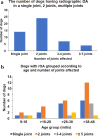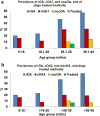Prevalence of radiographic appendicular osteoarthritis and associated clinical signs in young dogs
- PMID: 38310147
- PMCID: PMC10838335
- DOI: 10.1038/s41598-024-52324-9
Prevalence of radiographic appendicular osteoarthritis and associated clinical signs in young dogs
Abstract
This study aimed to determine the prevalence of osteoarthritis (OA) and associated clinical signs in young dogs. Owners of dogs aged 8 months-4 years from a single practice, were contacted in random order, to participate in a general health screen. Clinical and orthopedic examinations were performed. Each joint was scored for pain reactions (0-4). Orthogonal radiographs of all joints were made under sedation. Each joint was scored for radiographic OA (rOA) severity on an 11-point scale. Clinical OA (cOA) was defined as an overlap of rOA and joint pain in ≥ 1 joint. Owners completed OA questionnaires. The owners of 123 dogs agreed to participate. Overall, 39.8% (49/123) of dogs had rOA in ≥ 1 joint, and 16.3% (20/123) or 23.6% (29/123) dogs had cOA, depending on the cut-off value of joint pain; moderate (2), or mild (1), respectively. Owners of dogs with cOA observed signs of impairment in approximately 30% of cases. Only 2 dogs with cOA were receiving OA pain management. The most commonly affected joints in descending order of frequency were elbow, hip, tarsus, and stifle. Radiographically visible OA is common in young dogs, and 40-60% of dogs with rOA had cOA. However, OA-pain appears underdiagnosed and undertreated in young dogs.
© 2024. The Author(s).
Conflict of interest statement
NAT is an employee of Elanco Animal Health. BDXL is a paid consultant for Elanco Animal Health; JFI receives license fees for the LOAD and has engaged in paid continuing education lectures on behalf of Elanco. No other authors have any conflicts to disclose.
Figures




References
-
- Johnson JA, Austin C, Breur GJ. Incidence of canine appendicular musculoskeletal disorders in 16 veterinary teaching hospitals from 1980 through 1989. Vet. Comp. Orthopaed. 1994;7:56–69. doi: 10.1055/s-0038-1633097. - DOI
-
- Weighty issue of osteoarthritis.https://www.banfield.com/about-banfield/newsroom/press-releases/2019/ban... (2019).
MeSH terms
LinkOut - more resources
Full Text Sources
Medical

